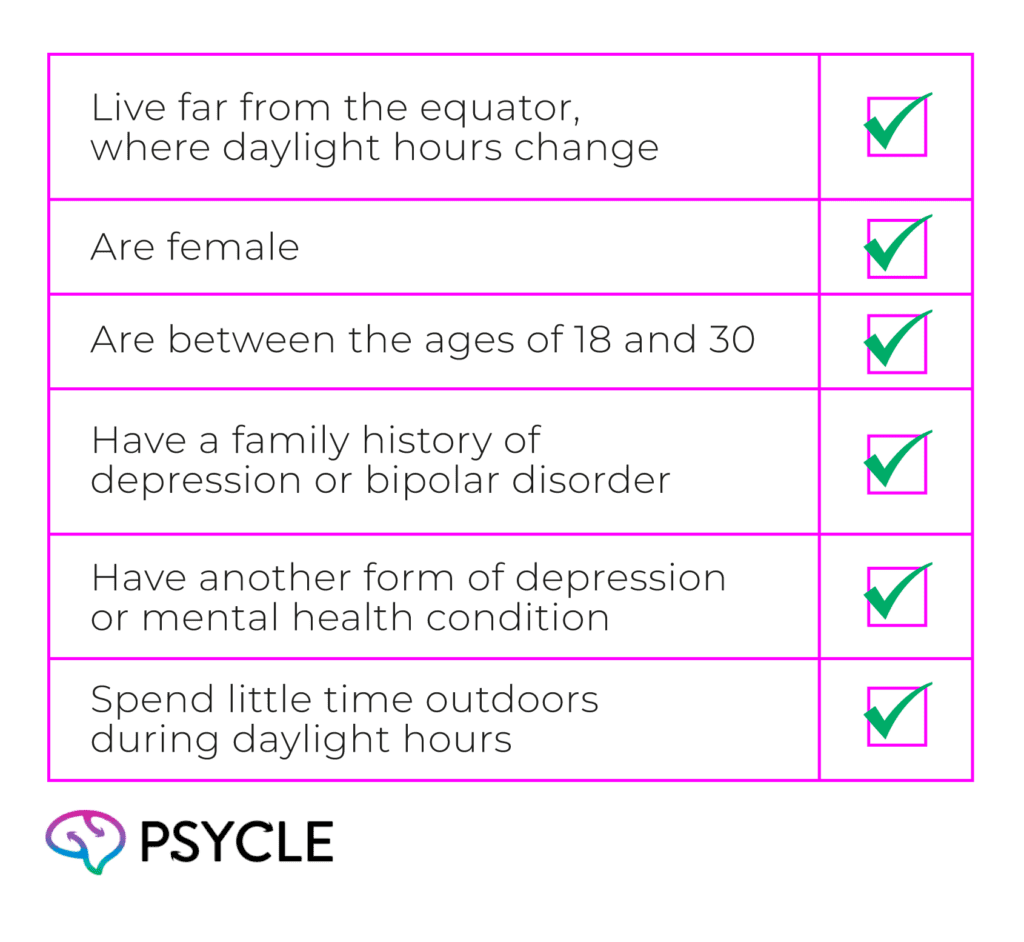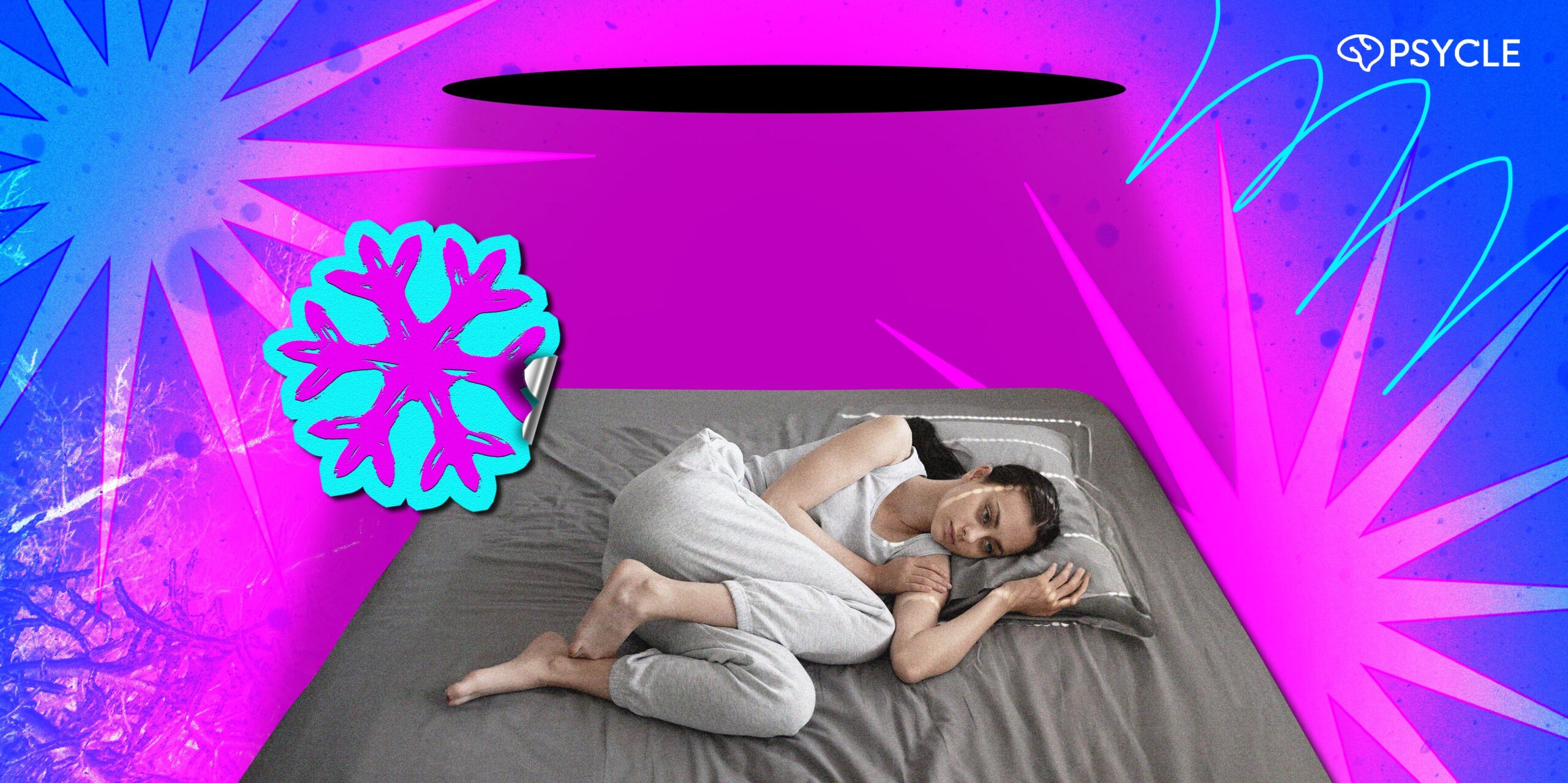When the seasons change, so can your mood. You may experience changes in energy, motivation, and emotional balance as shorter days begin. In rare cases, these changes also occur at the onset of summer.
In this article, we’ll explain the symptoms and causes of seasonal depression, otherwise known as seasonal affective disorder (SAD). We’ll discuss self-help tips and treatment strategies, so you can face the winter feeling more prepared.
Key Takeaways
- Seasonal depression symptoms return at the same time each year for at least two years.
- Winter SAD often causes fatigue, oversleeping, and increased appetite.
- Summer SAD can cause insomnia, appetite loss, and anxiety.
- Reduced sunlight, vitamin D deficiency, sleep disruption, and social changes can contribute to symptoms.
- Self-help strategies include light therapy, vitamin D, outdoor activity, exercise, and diet changes.
- Medical treatments include CBT, antidepressants, ketamine therapy, and TMS.
What Is Seasonal Depression?
Seasonal depression, or seasonal affective disorder (SAD), is a form of depression linked to seasonal changes. It follows a predictable yearly pattern and happens for at least two years in a row before a diagnosis is made.
The most common type is winter-onset SAD. Symptoms usually begin in late fall or early winter and improve during spring and summer. A less common form is summer-onset SAD, which starts in late spring or early summer and improves during the cooler months.
Seasonal depression differs from “winter blues,” a milder mood shift that affects many people but does not interfere with daily life. Symptoms of seasonal depression can be debilitating, affecting relationships, work, and overall health.
Seasonal Depression Symptoms
Winter-onset symptoms may include:
- Low energy or constant fatigue
- Difficulty concentrating
- Loss of interest in activities you usually enjoy
- Sleeping more than usual
- Significant changes in appetite and weight
- Feelings of sadness or hopelessness
- Withdrawal from friends and family
Summer-onset symptoms are typically different and include:
- Trouble sleeping (insomnia)
- Increased anxiety
- Agitation or restlessness
Causes of Seasonal Depression
The exact cause of seasonal depression isn’t fully known, but several factors appear to play a role.
Reduced Sunlight and Serotonin Levels
Serotonin is a neurotransmitter, which is a chemical in the brain that helps send signals between nerve cells. It plays an important role in mood, memory, and feelings of well-being.
Studies show that people have lower serotonin levels during the darker months. Sunlight exposure may help trigger proteins found in the skin that synthesize serotonin. When daylight hours drop, the body may make less serotonin, which can contribute to depression symptoms.
Vitamin D Deficiency and Mood Regulation
Vitamin D is a nutrient your body makes when skin is exposed to sunlight. It also comes from some foods and supplements.
Vitamin D helps the body produce serotonin and other neurotransmitters, such as dopamine and norepinephrine, that influence motivation, alertness, and energy. It also plays a vital role in overall brain health, helping regulate inflammation and neuronal communication.
The decline in vitamin D exposure during winter may be a key contributor to seasonal depression.
Sleep Disruption and Melatonin Changes
Melatonin is a hormone that helps regulate the sleep-wake cycle. The brain produces more melatonin in darkness and less in light. In winter, longer nights can lead to higher melatonin levels, which may cause fatigue and oversleeping. Research also shows that the normal variation in melatonin levels over a 24-hour cycle becomes disrupted during the winter months.
In summer-onset SAD, long daylight hours or hot, humid nights may reduce sleep quality. Poor sleep disrupts brain function, which could in turn impact mood regulation.
Psychological and Social Factors
In winter, shorter days and cold weather may lead people to stay indoors more often. Reduced social contact can lead to feelings of isolation. Fewer outdoor events and activities can make life feel less stimulating.
In summer-onset SAD, constant social events, heat, or longer daylight hours can cause stress or overstimulation. These factors may explain feelings of anxiety or restlessness.
Risk Factors for Seasonal Affective Disorder
Seasonal depression affects about 5% of adults in the United States each year. You may have a higher risk if you:

Self-Help Strategies for Managing Seasonal Depression
Self-care can help prevent seasonal depression and lessen its impact. Here are some tips to get you through the winter months:
Spend More Time Outdoors
Go outside in the morning for at least 20–30 minutes. Even on cloudy days, natural daylight can help regulate your body’s internal clock, and help rebalance serotonin levels.
Use a Light Therapy Box
A light box is a device that emits bright light similar to natural daylight. Use it for about 30 minutes each morning. Sit a short distance from the box with your eyes open but not staring directly at the light. Choose a model designed for SAD that filters out most UV light.
Take Vitamin D Supplements
Since our bodies produce less vitamin D during the winter months when sunlight is limited, supplementation can be beneficial. Vitamin D3 is the most effective form, as it is the most biologically active and helps raise vitamin D levels efficiently. You can also boost your intake through vitamin D–rich foods such as fatty fish, eggs, and mushrooms.
Practice Wintering
“Wintering” means adjusting your lifestyle to match the season rather than resist it. This might include cozy indoor activities, cooking warm meals, and focusing on rest. Accepting the slower pace of winter can make it easier to adapt.
Exercise Regularly
Physical activity increases endorphins and other brain chemicals that improve mood. It can be hard to motivate yourself to exercise when you’re feeling depressed, but you can start with something light, like 20 minutes of yoga or going on a brisk walk.
Eat a Balanced Diet
Choose foods rich in protein, whole grains, fruits, and vegetables to support overall health. Limit high-sugar snacks and refined carbohydrates, which can cause energy spikes and crashes.
Maximize Light at Home
Arrange your living space to get more daylight. Open blinds during the day and sit near windows when possible. Consider using bright, cool-colored LED bulbs indoors.
Treatment Options for Seasonal Depression
If symptoms are affecting your day-to-day life and lifestyle changes don’t help, you may consider medical treatments. Speak to a mental health professional, and they can recommend different approaches based on your medical history and symptom severity.
Cognitive Behavioral Therapy (CBT)
CBT is a type of talk therapy that helps you identify and change negative thought patterns. It can help you develop coping skills and better manage your mood. Research shows CBT can be effective for seasonal depression and may have lasting benefits after treatment ends.
Antidepressants
Antidepressant medications work by increasing serotonin levels, which can help stabilize mood. They are often considered a first-line treatment for depression. However, they may not be the best option for seasonal patterns, since they can take several weeks to become effective and also require time to safely taper off once winter ends.
Ketamine Therapy
Ketamine is a medication that has rapid-acting antidepressant effects. It affects a different brain system than traditional antidepressants. It is usually given in a clinic through an IV or nasal spray under medical supervision.
Transcranial Magnetic Stimulation (TMS)
TMS uses magnetic fields to stimulate specific areas of the brain linked to mood regulation. It is non-invasive and done in a clinic. A course of TMS usually involves daily sessions over several weeks.
There’s no one-size-fits-all approach to treating seasonal depression, and you may need to try multiple strategies before finding the right one, or the right combination. However, know that you’re not alone, and there’s lots of help available.
FAQs
How Do I Know if I Have SAD and Not Just “Winter Blues”?
The “winter blues” usually involve mild changes in energy or mood. SAD, on the other hand, is a clinical condition that causes significant impairment in daily life, such as ongoing sadness, sleep disruptions, loss of interest in activities, and difficulty functioning at work or school.
Is Light Therapy Safe, and Are There Any Side Effects?
Light therapy is considered safe for most people when used correctly, but it can sometimes cause mild headaches, eye strain, or nausea. People with eye conditions or bipolar disorder should consult a doctor before starting, since the light may worsen symptoms in rare cases.
Sources
- https://www.nimh.nih.gov/health/publications/seasonal-affective-disorder#part_6692
- https://pubmed.ncbi.nlm.nih.gov/11109298/

